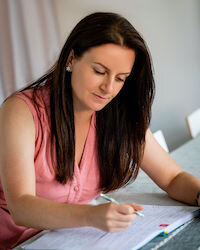Impact in Qualitative Research: Gemma McKenzie - Working with Creatives to Disseminate Qualitative Research

Gemma McKenzie has recently completed her PhD on women’s experiences of freebirthing in the UK. Here, she reflects on the process of working with creatives to disseminate her qualitative research in an impactful way.
“I couldn’t get through it.” These were the words of my highly intelligent and well-educated friend after I asked her what she thought of the literature review I had published at the start of my doctorate. My research centred on women’s experiences of intentionally giving birth without doctors or midwives present - also known as freebirthing. It is both a feminist and human rights issue which links to a woman’s ability to control who touches her body and when. I had spent almost a year trawling through databases and self-published books attempting to capture everything I could on the subject, and in my mind, I had produced something that was at least, well – readable.
"Clearly the article was of a publishable standard. It had, after all appeared in a respected academic journal. But who could actually read it? Regardless of its Open Access status – was it truly accessible?"
I wondered afterwards, what was the point of spending years researching a topic if only a handful of people could understand what I had written about? Whilst all academic researchers must publish academic papers – this is intrinsic to the job – surely the role also requires that the results of the research have some impact in the real world? And for that to happen, people outside of academia have to be able to not only physically access the research (i.e. it’s not locked behind a paywall) – but they must also be able to understand the output of the study.
Armed with an idea as to how I could make my research more widely accessible, during lockdown I successfully applied for a £1,000 grant from the Economic and Social Research Council (ESRC) to create a short video of my work. I had begun analysing my interview data using the Voice Centred Relational Method. In short, the method requires four readings of the data, one of which produces a form of poetry called I-poems. With ethical approval and using some of my ESRC funds, I worked with four interviewees to develop ideas for the film. Our aim was to present some of the poetry and to provide insight into women’s lived experiences of freebirth. I hoped that the video could be easily shared online and watched by any English speaker around the world. Using poetry and film, I wanted to capture people’s imagination, make them think and encourage them to seek out more information on the subject.
"One of the most daunting things about disseminating research beyond the comfort of the academe is that at the time I had no skills or experience in this type of creative output. With a miniscule budget, I had to create a team of people who could take my idea forward and bring it to fruition."
My friend – Jana Vodickova - is a graphic designer and art director, and she volunteered her assistance. I also knew there was a local creatives group near where I lived, so I researched the members’ profiles online. I found Calum Morrison who is a photographer and film maker. He was available, interested in the project and in budget. Terrified, I was now ready to produce my first film.
Jana’s initial idea was to film the poems in a large bright space, but this would not have worked due to government restrictions during the pandemic. Instead, we decided to film in an outside wooded area where we could attach the poems to thin rope tied between two trees. When I first heard of this idea, I was unsure what to make of it, but I trusted Jana and decided to step back from attempting to take control. I conceded that I was not an artist, knew nothing about how to make words appear visually attractive and that I was no longer the ‘expert.’
The location I picked with one of my interviewees was in a local park which contained a small copse of trees. Inside the thicket gave the illusion of a much bigger forested area and we were fortunate that on the day of filming the wind was blustery. Consequently, when the poems were attached to the rope, they blew about like clothes on a washing line, and this added to the imagery and effect we were trying to convey.
On the day of the shoot Jana used her creative skills to direct the film. This was an interesting experience as she had an eye for artistic natural beauty that I do not have. She spotted patterns in the way leaves had fallen and was drawn to textures in bark and colours in trees that I would have walked past and dismissed.
"My role on this day was to do little more than carry everyone’s bags and equipment and provide biscuits for the group."
I handed the art direction, filming and editing over to Jana and Calum completely and made very little contribution to these aspects of the film. On reflection this was absolutely the correct thing to do as my creative ideas cannot compete with those of people who do this work daily.
In the meantime, I had asked nine women, including interviewees, birth activists, doulas and friends to record themselves reciting the poems. Given that we only had five weeks to complete the film and that we were in the middle of a lockdown, women did so alone at home without any kind of direction. Their tone and mood on the recordings therefore reflect their own interpretation of the poetry. The quality of the recordings also differed as some people used microphones and others spoke directly into a WhatsApp recorder.
Throughout my doctorate, my research was supported by a human rights charity called AIMS (Association for Improvements in Maternity Services). They agreed to host the video on their YouTube channel and promote it on social media. To date, it has had over 1,400 views on YouTube and 3,300 on Facebook. Of course, there is no guarantee that every viewer watched the film to the end, but given the positive response I received online, it was clear to me that it reached a completely different audience than my academic papers. It garnered lots of interaction from activists, doulas and parents and led to several invitations to speak to charitable organisations.
"The main thing I learned from this experience was that my research could be presented in various ways to different audiences."
I did write an academic article on the I-poetry, but the response was more predictable and limited to the world of academia. Working with creatives can be both scary and exciting, and I intend to continue to disseminate my research in colourful and eclectic ways. In fact, I am now on my second artistic project: the creation of a Wellcome and KCL funded graphic zine on consent in maternity care with an artist named Michelle Freeman .
Regardless of the topic being researched, there is always the potential to be creative with the output. From my experience, this is the best way to extend research findings beyond academia and present it to the wider world. Whilst academic publications are necessary, pursuing creative outputs promotes both humility and learning for the researcher, and creates a body of work that is much more accessible to the general public.
You can watch my short film below, and more information on the freebirth study can be found at www.gemmamckenzie.co.uk
